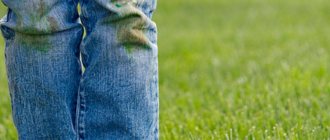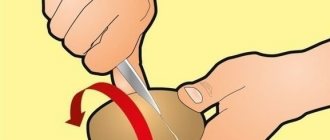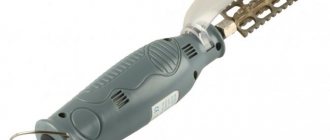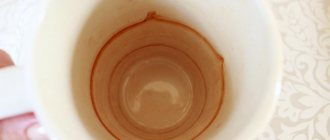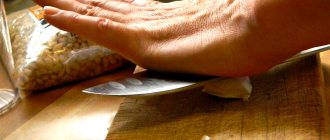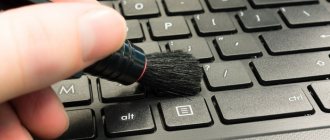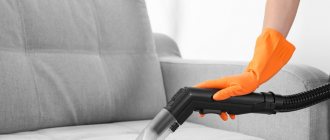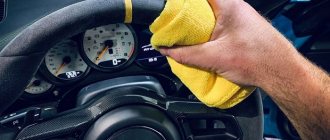Professional interior cleaning (detailing) is not cheap, but if you do everything yourself, this process will be surprisingly inexpensive.
Moreover, most likely, you already have some of the necessary tools and cleaning products in stock. The interior of the car can be as dirty as the exterior, but you won't even know it. Dirt and dust can be found inside the fibers of the carpet and are added every time you get into the car. Contaminants on clothes and skin are transferred to the seat upholstery, and the grooves in the plastic also accumulate dirt. Cleaning the interior is not a difficult process if you have the right information about cleaning products and cleaning methods. A clean interior increases the selling price of the car and makes it pleasant for both the driver and passengers to be inside the vehicle. In this article I will tell you in detail how to clean the car interior with your own hands. The content of the article:
- Tools and materials for interior cleaning
- Special tools for professional interior cleaning
- Interior cleaning rules
- Interior cleaning sequence
- Headlining
- Cleaning plastic
- Seats
- Carpet covering
- Cleaning glass and rear view mirrors
- Elimination of unpleasant odors
- Drying the interior
- Protecting the cleaned interior
How often should the interior be cleaned?
- Regular cleaning of the interior with a vacuum cleaner, wiping the instrument panel, plastic elements and glass will keep it clean and should be carried out as the interior of the car becomes dirty.
- Every time you wash the car body, you need to wipe the interior with damp microfiber. It effectively removes dust and surface dirt and is also capable of removing up to 99 percent of bacteria thanks to its unique fiber structure.
- Under normal operating conditions, thorough cleaning should be carried out approximately 1-2 times a year. After washing and cleaning, apply protective compounds. They repel moisture and dust, and also protect the plastic from drying out and fading.
- Thorough interior cleaning (detailing, which differs from regular washing in that it pays close attention to every detail) includes cleaning the floors, rugs, seat upholstery, glass and rear-view mirrors, door cards, as well as removing foreign odors. Each surface requires a specific cleaning method, including the use of detergent mixtures, stain removers, brushes, microfiber cloths, special equipment, and other auxiliary tools.
Tools and materials for interior cleaning
The interior of the car consists of several types of materials. They get dirty in different ways. A car enthusiast looks at the variety of elements and thinks that each type of material requires a different type of cleaner. And manufacturers are happy to offer a wide range of “special” products for each interior element. In fact, a high-quality multi-purpose (universal) cleaner (All-purpose cleaner, for example, Meguiar's) can clean almost any material. An all-purpose cleaner can replace many special cleaning compounds. It is important to use the cleaning mixture with the correct brushes and towels/wipes. It is sold in detailing stores and is intended for cleaning any parts of the interior. Has good foaming properties and contains fabric softeners and other additives. Depending on the type of contamination and material, this mixture can be diluted with water in different proportions indicated on the label.
Meguiar's All-purpose cleaner can clean any material.
It is diluted with water, destroys dirty accumulations and lifts them from the surface. It needs to be sprayed, allowed to soak in for a couple of minutes and gently wiped with microfiber. After this, wipe the clean area with a towel, removing any residue. Most parts of the interior can be washed simply with microfiber and warm water. It should always be well wrung out. High-quality microfiber has special properties and is able to absorb and retain a lot of dirt, without scratching the surface or leaving streaks. Read the detailed article “microfiber for cars, advantages, choice, application,” which describes the operating principle of this unique material, its properties and varieties.
Most surfaces, including upholstery, can be washed with microfiber and warm water.
For more serious stains, it is better to add the diluted All-purpose cleaner described above. It can be replaced with other chemicals, but the effectiveness will deteriorate. Of course, you should not exclude special products that are also mentioned in this article.
So, to clean the interior you will need:
- Vacuum cleaner with attachments for cleaning floors and other materials.
- It is important to have compressed air (from a compressor or in a can).
- Chemicals for cleaning. This is everything you need to clean natural and artificial leather, plastic, fabric/velor upholstery and carpet.
- Wiping and polishing materials. For serious detailed cleaning, you need a set of different microfiber cloths, from coarse ones to wiping ones that do not leave lint or streaks.
- Brushes, brushes (for paint or a special brush for detailing) and applicators. They will come in handy when cleaning ventilation grilles and hard-to-reach places.
- Protective composition for the interior (we will look in more detail at the end of the article)
- Window cleaner
- Bucket with warm water
Secrets and tricks of ideal self-dry cleaning of car interiors
Do-it-yourself interior dry cleaning becomes somewhat more effective if you resort to a few tricks that will help make this process not only more productive, but also more accessible.
Let's highlight a few of these secrets that can be excellent helpers in the process of dry cleaning the car interior yourself:
Fresh spots . To avoid spending a large amount of money on cleaning fresh stains, you can use a regular damp cloth. It will cope with its task, and you won’t have to fill everything with foam or do any serious cleaning.
Traces of fruits or berries . A common problem during the summer season are traces of fresh berries and fruits that have released their juice. Over time, this juice dries out and becomes sticky, which is why dust and other small debris begin to stick to it.
You can get rid of traces of fruits and berries using regular warm water, to which a small amount of liquid soap is added. After the procedure, the prepared solution must be rinsed with clean water.
Cleaning up coffee stains . Ammonia is often found in the car first aid kit, and one of the ways to use it is to scrub away tea and coffee stains. After getting rid of the coffee stain, you need to get rid of traces of ammonia using warm running water. Ammonia also works great on chocolate and other traces that contain sugar.
Getting rid of traces of blood . Small cuts happen even to the most careful drivers, and traces of blood may remain on the steering wheel upholstery, seats or soft parts of the door panels. You can get rid of blood stains with cold water and salt.
Correct application of these secrets will greatly simplify the process and will also help save chemicals that can be used the next time you dry clean the car interior.
Special tools for professional interior cleaning
To help the detailer, tools such as a steam cleaner, tornador and extractor are used. Let's take a closer look at these tools.
- The steam generator is designed for deep cleaning and is capable of cleaning heavy stains on fabric and plastic. The steam needs to be applied for 2-5 seconds and dirty accumulations will rise from the surface. Do not keep the steam generator in one place for too long. Steam can damage the material if it heats it up too much. 75–90% of stains can be washed with a universal cleaner and a steam generator with a nozzle wrapped in microfiber. After exposure to the steam generator, the material dries quickly. Steam cleans fabric and skin well. Steaming will remove stubborn stains and kill bacteria. Cheap models can do a good job on leather, but do not clean fabric well.
The photo shows the driver's seat of a Hyundai Elantra. As you can see, it is quite dirty. This type of upholstery is very difficult to keep clean because it stains easily. In this case, various liquids were spilled on the seat more than once.
Professionals performed a three-stage cleaning method. It includes washing with a universal product, exposure to steam and exposure to an extractor (hot water extraction).
- Tornador injects the cleaning agent deep into the material and destroys stubborn dirt. Tornador works quickly and effectively. This device is powered by a compressor and mixes air with detergent in a tank. Then it pumps this mixture like a tornado. The design of the tornador itself involves the destruction of dirty accumulations and knocking them out. For people unfamiliar with this tool, the cleaning process looks like a miracle. An alternative would be to first spray a little universal product, rub with a brush and use a tornado with water. Tornador has an excellent effect on hard-to-reach places and any secluded corners. Cleans waterproof materials well, including plastic. The disadvantage of a tornado is that its operation requires a fairly powerful compressor, which is not cheap and takes up space. Read more about this tool in the article “Tornador, a dry cleaning machine.”
- The Heated Extractor is used on carpeting and upholstery both independently and after exposure to steam or tornado. When operating independently, the unclean area is first cleaned with a vacuum cleaner and brush, then washing liquid is sprayed. It is necessary to let the washing mixture act for 3-4 minutes and rub it with a brush at the same time, for better penetration between the fibers of the material. Next comes the Heated Extractor. This device heats up the water, injects it into the material and immediately sucks it back into its tank. The extractor has a powerful motor, water heater and pump.
The most popular dry cleaning products
- Koch Chemie MEHRZWECKREINIGER
This product is perfect for cleaning textile, leather and plastic surfaces. Effectively removes any contaminants, but is not safe for human skin because it has an alkaline composition. Koch Chemie does not need to be washed off with water. It is enough to remove it with a napkin or towel. The product prevents fading and stretching of the material.
- H3 – ATAS Vinet
Excellent for removing oil and grease stains, organic contaminants and unwanted odors. Universal for all surfaces. Works more efficiently if it is sprayed with a dispenser during the “wet” cleaning process
Like the previous product, ATAS Vinet can not be washed off with water, but removed with a dry cloth. Despite its effectiveness and versatility, the price of the product is low.
- GRASS Universal Cleaner
Suitable for cleaning leather, velor and fabric in the car interior. The composition includes flavors, complexing agents and surfactants. The product can be used for self-cleaning, but only with rubber gloves.
- Dry interior cleaning RUNWAY Dry Interior Cleaner
As the name suggests, this product can be used without water or additional equipment. Before use, shake to form foam. Remove the product from the surface using microfiber or a medium-hard brush. Great for velor and carpet.
- Dry cleaning of Xado RED PENGUIN interior
A universal product that removes greasy stains and restores fabric structure. Suitable for manual DIY cleaning. Removed with microfiber or rags. It is most effective to use together with a washing vacuum cleaner.
Interior cleaning rules
- Before using cleaning chemicals, always vacuum first.
- When cleaning the interior, it is sometimes better to apply the detergent or protectant to a cloth rather than spray it onto the material to avoid splashing adjacent areas.
- In most cases, the interior is dirtier than you expect, and cleaning individual visible stains will create isolated clean spots, leaving the rest of the area dirtier and darker. Therefore, it is better to clean large areas or the entire surface.
- Cleaning products usually come with a warning to try them on an inconspicuous area first. If a stain forms, it will not be visible, and you will understand that this substance is not suitable for a particular material.
- Interior cleaning chemicals (for example, diluted Meguiars All Purpose Cleaner) act on dirt, loosening it and lifting it from the surface. Therefore, you need to spray the cleaning chemical and wait a minute for it to take effect. That is, in most cases, it is not necessary to scrub anything. Next, you just need to wipe the material with a rag.
- To clean the interior, do not use a sponge, but only microfiber. Debris gets into the pores of the sponge and even after rinsing it, some of it remains and then affects the area being cleaned.
- There's no need to rush. Thorough cleaning of the interior will take 2-3 hours or more. If you are going to clean the interior of not only your vehicle, but work in this area professionally, then the cleaning speed will increase gradually, with experience, while maintaining high quality.
When is professional dry cleaning not advisable?
The thought of taking your car to a car wash for dry cleaning may seem like a good idea when it comes to cleaning the inside of the car. Washing the interior at the station will definitely save your time (possibly nerves) and eliminate the hassle.
If your budget doesn’t allow you to spend a couple of extra thousand, and you have a free sunny day in the near future, then why not clean the seats and car yourself. You should think twice even for minor or spot contamination. It is likely that single stains can be removed by yourself, then there is no point in spending money on a complete cleaning service.
Interior cleaning sequence
- Before starting cleaning, remove foreign objects (coins, papers, things). Move the seats as far forward as possible and then back to get better access and not miss anything.
- Remove the rugs and clean them separately. It is better to wash the rugs in a washing machine.
- Next comes a quick vacuuming. At this stage, you do not need to vacuum thoroughly, but only remove large surface debris and dust. If you have access to compressed air, you can start by blowing. A vacuum cleaner in blowing mode is another way to get dust out of hard-to-reach corners. It is necessary to blow out the floor, seats, various cracks, door trim, console, etc. That is, it is necessary to move the accumulated debris. This will make it easier to vacuum. You can also use a soft bristle brush and vacuum at the same time. Read the detailed article “how to vacuum the interior of a car.”
When vacuuming the interior, move the front seats as far forward and back as possible to gain better access underneath.
- Car enthusiasts usually start cleaning their interiors from the floor. Then debris and dust from chairs and other parts will fall onto the cleaned floor. Professional detailers start cleaning the interior from the top and work their way to the bottom.
- Work systematically throughout the interior, from left to right, from back to front, etc. Choose a sequence that is convenient for you. Some surfaces only need to be vacuumed and protected, while others need to be washed with special chemicals, dried and only then applied protection. It is more convenient to clean individual parts of the interior, because you do not have to rearrange the equipment many times.
- After cleaning, you need to do a final blowing with compressed air (if possible).
- After completing the procedures, vacuum the interior again. Now the previously stuck debris has loosened and is easier to remove.
- Cleaning doorways.
- The windows are cleaned last.
- Finally, you need to do a general final inspection, checking that everything is clean.
Cleaning the headliner
The ceiling must be handled very delicately, not soaked too much in moisture, and not exposed to anything hot, so as not to damage the adhesive connection of the upholstery to the ceiling substrate and cause it to peel off. Using a steam generator with a handheld attachment wrapped in a microfiber towel will also clean the ceiling well. The article “do-it-yourself car ceiling cleaning” describes the detailed process of cleaning the ceiling.
And finally...
The very last step in cleaning a car is drying it. If you do not clean carefully, excess moisture can cause the ceiling upholstery to peel off. In addition, any moisture is, first of all, mold and the unpleasant odors associated with it. That is why it is recommended to dry and ventilate the car interior after dry cleaning for at least 7 hours. During this time, not only excess moisture will disappear, but also those “chemical” odors that specialized cleaning products leave behind.
Cleaning interior plastic
- Vacuum the dashboard, center console and doors using a soft-bristled attachment.
- A simple microfiber cloth with warm water works well for washing the instrument panel. You can add All Purpose Cleaner or dish soap.
- If dirt has become embedded in the texture of the plastic, then using a toothbrush will clean it more thoroughly. After this, the plastic needs to be wiped off.
- A window cleaner (without ammonia) can also be used to clean interior plastic.
- To remove old protective layers on plastic, use a well-diluted multi-purpose cleaner (All Purpose Cleaner). Water with fairy and a microfiber cloth will also work.
- Some marks cannot be washed off in the usual way. In this case, isopropyl alcohol is suitable. For example, it can effectively wash away black marks from shuffling shoes.
Types of dry cleaning
There are two main types of dry cleaning: dry and wet. The choice depends on the type of contaminants that need to be eliminated. Let's consider each type separately.
Wet dry cleaning
Such cleaning involves the use of water-soluble mixtures that absorb dirt and then are easily removed from the surface. What is not removed after the mixtures is removed with a vacuum cleaner or with napkins.
This type of cleaning is suitable if dirt has become embedded in the upholstery. Products used for wet cleaning are hyperallergenic and safe for human skin. In addition, this procedure can replace disinfection.
Dry cleaning
Dry cleaning sometimes acts as a preparation for wet cleaning, but can also be done separately. In this case, tools such as a vacuum cleaner and hypoallergenic spray are used.
As a rule, such cleaning is carried out more often than wet cleaning. It is needed for contaminants that can be removed mechanically, or to eliminate unwanted odors.
The average time it takes to clean the interior is approximately 5-8 hours. Most of this time is spent drying, so dry cleaning is much faster.
Dashboard
The front panel is the area of the interior that comes into view most often. Unfortunately, it is not easy to clean due to the abundance of buttons, switches, ventilation flaps and small parts. Having the right tools makes cleaning much easier. The brush will be able to sweep away the dust between the buttons, and the vacuum cleaner will simultaneously suck it up. Whatever material the dashboard is made of, it is the most difficult area to clean. The angle of the windshield on some cars creates hard-to-reach areas. Moreover, they are the most dusty. Vacuum all dust before applying cleaning chemicals. The control panel's many buttons and levers make thorough cleaning difficult. To more effectively clean these areas, use the following method. Wrap a thin rag around the tip of a flathead screwdriver to clean out the grooves and joints. If you are afraid that the screwdriver will damage the plastic, then instead of a screwdriver, use a small disposable plastic knife in the same way. Cotton swabs are also useful for cleaning tight spaces. After all cleaning, it is better to apply a protective compound to prevent the material from fading and cracking.
We will clean the doors and car panels
The next step is cleaning the doors and dashboard. Let's start with the doors.
The trim can be washed in the same way as the ceiling and with the same products. But it is advisable to clean plastic and chrome elements with special products for metal and plastic. Then the surface must be treated with polish with an antistatic agent and wiped dry.
First treat the panel with a brush to remove dust particles around the buttons and switches, and then treat it with any detergent for plastic.
We wash mirrors and glass with any product intended for this purpose and wipe them dry.
Seat cleaning
- In vehicles, three main types of materials are used for seat upholstery: natural and artificial leather, textiles. Each type of material requires a different cleaning method.
- Textiles are more prone to absorption and staining.
- Before applying detergent and starting cleaning, you need to vacuum the material.
- Don't miss the area between the back and the bottom where different types of debris can be found.
- The recesses in the seam area can be cleaned with a toothbrush and vacuumed.
- Use a round bristle attachment on your drill. Do this at low speed to avoid damaging the material. After its operation, the chair needs to be vacuumed again.
- After removing visible debris, spray the material with cleaner following the manufacturer's instructions. Usually, it is better to moisten the material, but not completely soak it in moisture. Next, you need to carefully work with a brush with soft bristles.
- It is recommended to concentrate on small segments so that the cleaning chemicals do not remain in one place for too long. Work in stages. Do not start cleaning the next segment without finishing the previous one.
- Treat the chairs in sections, and then the entire surface.
- The material may be sensitive to various chemicals, so you should test the product on a small, inconspicuous area first before moving on to the main area being cleaned.
- Universal chemicals (All Purpose Cleaner) diluted in water work well on textiles.
- Spray the interior cleaner and wait 20 seconds or more to take effect. Rub with a brush for better effectiveness, then wipe off any remaining residue with a damp cloth.
- If something doesn't come off the first time, repeat the step.
- When cleaning, you can soak the material and collect moisture by touching it with microfiber.
- It is necessary to moisten the chairs less, using compositions that form dry foam. For example, Turtle Wax upholstery cleaner.
- Most fabric upholstery in modern cars is made from a mixture of polyester (polyester), which makes it very durable. Such material cannot be washed perfectly. This applies to heavily soiled fabrics with very tight weaves.
- Steam is also used for cleaning. Even an iron with the appropriate function is suitable for this. This is done at a minimum distance, but without touching the chair. This will also remove the unpleasant odor because it kills bacteria.
- It is recommended to dry the chairs naturally, so always plan cleaning when you are not going anywhere in the near future. It's better to clean them early in the morning. On a warm day they will dry in a couple or three hours.
Cleaning leather seats
Over time, dirt eats into the skin, changing its color. Cleaning it is similar to cleaning fabric upholstery, but has several important differences. While this material resists staining well, it is more sensitive to abrasion. This must be taken into account when vacuuming it with plastic attachments. Special formulations are sold, usually having a creamy consistency, and not sprayed or in the form of shampoo. Good cleaners have the right pH balance. Most leather products are applied to the chair and the microfiber scrubs it down. It needs to be turned over to the clean side more often. After cleaning, allow the seat to dry thoroughly for several hours, then apply a leather conditioner to keep it soft. For more information about caring for a genuine leather interior, read the article “caring for a leather interior.”
Cleaning Alcantara upholstery
When cleaning Alcantara, do not rub it too vigorously. This will ruin its texture. It is not recommended to treat Alcantara with steam. To clean it, you need to use a soft brush, dry cloth or just a vacuum cleaner. Then wipe the Alcantara with a damp, but not wet, towel.
Cleaning artificial leather seats
Compared to natural leather, caring for artificial leather is easier. The products you have on hand will be suitable for cleaning. It can be easily washed with damp microfiber and diluted washing liquid. There are also compositions that include cleansing and protective components at the same time. Also see the article “caring for eco-leather”.
Procedure for cleaning the car interior
To achieve the best result in all respects, when cleaning the car interior, it is advisable to follow a certain sequence of actions. This strategy will allow you to avoid unnecessary unnecessary labor costs and save your time and money.
Immediately before starting all work, it is advisable to turn off the power to the car, since accidental contact with moisture on conductive elements can lead to serious consequences.
The most acceptable cleaning algorithm consists of the following actions:
- drive the car out of a closed room into an open area;
- remove the covers and take out the rugs;
- shake out and vacuum the covers;
- wash/wipe the rugs and leave them to dry outside;
- fold out the seats;
- vacuum the interior;
- wipe plastic elements from dust;
- vacuum door cards/interior panels;
- apply auto chemicals to fabric elements, starting with the ceiling trim;
- after some time, clean them evenly with a soft bristle brush;
- Rinse and dry cleaned surfaces.
When working with chemicals, you should not neglect the manufacturers' recommendations in terms of personal protection. Therefore, when applying cleaning products, wear rubber gloves on your hands, and in the case of the ceiling, safety glasses.
Article on the topic: Why the CHECK light is on in the car: what to do, is it possible to drive and how to put it out
It is advisable to carry out each of the described procedures taking into account some nuances, which we will get to know in the future.
Ceiling covering
When carrying out ceiling cleaning work, you must follow certain requirements. The fact is that there are often cases when, as a result of a negligent attitude to this procedure, irreparable consequences often arose, leading to the loss of the aesthetic appearance of the interior.
The presented procedure includes several stages:
- preparatory actions;
- cleaning the ceiling from dust;
- applying a cleanser;
- removing detergent;
- drying.
The first stage involves protecting the interior from moisture. To do this, before applying detergent, you should cover the seats with a film covering.
In the future, it is necessary to remove all dust from the ceiling. A damp microfiber is ideal for this.
The 3rd stage involves applying a cleaning reagent. It is best to use a spray product. It should be applied evenly to the entire surface of the ceiling. Try to avoid streaks and smudges.
Do not wash off the detergent immediately. It should penetrate the pores of the ceiling covering. In this regard, you should wait 3-5 minutes.
This is interesting: How to connect a Pioneer radio according to the diagram and wire colors
After the required time, the detergent should be removed from the ceiling surface. It is best to use the same microfiber, slightly moistened with water, for this.
Inner side of doors
It's time to tidy up the door cards. For this, any detergent will do. It is pre-diluted in a container with warm water until a thick foam forms.
After this, they resort to the following simple manipulations:
- moisten the panels with water using a spray bottle;
- apply detergent to the panels with a microfiber cloth;
- wait the prescribed 5-10 minutes;
- remove the reagent from the surface of the panel;
- dry the treated surface.
Dashboard (plastic)
In the case of plastic elements, everything is much simpler. In this case, the likelihood of unwanted consequences is extremely minimal. At the same time, you should still adopt some techniques and methods.
- first of all, get rid of dust with a damp cloth;
- apply a pre-prepared reagent solution, the concentration of which should not exceed the specified value;
- remove the reagent with a damp cloth;
- treat the surface of the plastic with protective agents;
- treat the plastic with polish.
Seat upholstery
When carrying out the work presented, fabric seat upholstery requires special handling. To avoid damage, you should use special wipes and a brush with soft bristles.
Only recommended types of stain removers should be used as a detergent. Practice shows that using a solution based on ordinary laundry soap and washing powder is quite justified. Both are applied to the contaminated surface. After this, this reagent is rubbed into the material and removed, followed by drying. .
Leather and leatherette
In the case of leather, you need to be extremely careful. In this case, you should not resort to using strong detergents and solutions . It is also worth remembering that high concentrations of reagents also have a detrimental effect on the condition of leather materials. So, having taken these simple recommendations into account, let’s begin to wash the leather interior.
Be sure to read: How cylinders are numbered, types of their location in the engine
Such a procedure includes the following components:
- removing dust and debris using a vacuum cleaner;
- uniform application of low concentrated cleaner;
- removal of solution;
- drying.
Velours
The presented material is very susceptible to various types of chemical reagents and requires special treatment. That is why, in this case, it is extremely important to use only special upholstery cleaners.
Products for cleaning fabric and carpet upholstery from German manufacturers have proven themselves well. Such solutions are sold in the form of aerosols. The method of using them is quite simple.
- the aerosol is evenly applied to the material;
- removed with a sponge after some time.
To guarantee the desired result, before applying the reagent to the entire surface of the material, it is advisable to try it in action somewhere in an inconspicuous place. If you are completely satisfied with the result of such a test, the product can be safely used everywhere.
Alcantara
In this case, the so-called Alcantara cleaner will come to the rescue. This foaming agent can be purchased at any auto store.
It should be applied evenly to the upholstery surface with a microfiber cloth. After 2-4 min. The solution must be removed with a damp cloth and wait until it dries completely.
Knitted chairs
When carrying out work with the presented coating, it is recommended to use special extractor devices for pneumatic dry cleaning.
They are capable of producing low-humidity foam, which has the best effect on the quality of cleaning knitted upholstery. Any certified reagent from the professional line of products is suitable as a cleaner.
Flooring
It's time to tackle the flooring. As a rule, in this case we are talking about pile floor coverings.
To achieve the desired result, just follow the following recommendations:
- vacuum the trim;
- treat the surface with carpet detergent;
- allow the reagent to soak in;
- rinse off the detergent;
- dry the casing.
Vanish can be used as a detergent for carpets.
Drying after dry cleaning
The final component of the presented works is drying. At this stage, it is important to pay attention to all hidden cavities and hard-to-reach places. This aspect particularly applies to floor upholstery.
Excessive dampness under car mats can lead to corrosion. This cannot be allowed to happen. Therefore, when drying, use a vacuum cleaner and ensure that all upholstery elements are completely dry.
On the subject: How to remove a radio without pullers and keys
As for fabric materials, it is worth noting their increased hygroscopicity. Therefore, when cleaning, you should not overly saturate them with moisture. One way or another, in the case of them, you need to achieve complete drying under conditions of natural air circulation.
Removing stains
There are many different factors that affect the ability to remove a stain. For example, its age and degree of contamination.
Let's look at the types of stains and how to clean them:
- Water soluble stains. Fruit juice, jam, syrup, ketchup, chocolate, ice cream and mustard. Clean by repeatedly dabbing with a damp towel, touching the clean side each time.
- Blood, eggs, urine - wipe with a damp cloth.
- Tomato sauce, coffee - soak in lemon juice, then wipe off with a damp cloth.
- Insoluble in water (cosmetics/lipstick, mascara, eye shadow), perfume, oil, grass marks. Rub with ethyl alcohol (not too much), blot with a damp cloth.
- Chewing gum. Place a plastic bag filled with ice on top of the gum. When the chewing gum becomes hard, remove it piece by piece and treat small residues with ethyl alcohol.
- Persistent. Repeat the cleansing effect several times.
- It is better to wash off even water-insoluble stains with water after cleaning them with detergent chemicals.
- Natural stain remover mixture: Mix one cup of water, half a cup of white vinegar and half a tablespoon of dish soap. Mix the ingredients and pour into a spray bottle. Spray onto the stain and wipe with a damp cloth until it is removed.
- Avoid rubbing the stain to prevent it from penetrating deeper into the material.
- Start washing the stain from the outer edge towards the center to prevent it from spreading.
Stains on leather seats
- Use nail polish remover or rubbing alcohol. Soak the stain with a cotton swab moistened with alcohol. When it rises from the surface, remove it with a rag soaked in hot water and liquid soap.
- Take a non-gel toothpaste and a toothbrush to gently apply it.
Carpet cleaning
- Depending on how dirty the rest of the interior is, you may want to give the floors and area rugs a thorough cleaning first or last. If, when cleaning the seats and instrument panel, the lower part of the interior gets dirty, then the floor will have to be cleaned again.
- Not all carpeting is created equal. The more densely it is woven, the more difficult it is to wash. Some inexpensive models of cars have a very tightly woven material on the floor, which only looks like carpet, but has no pile. This material is very difficult to vacuum, as dirt is eaten between the densely spaced fibers. For a better understanding, an analogy with washing hands is suitable. If you do this in a relaxed state or with your fists tightly clenched.
- Cleaning the floor becomes more difficult not only because of the material itself, but also because of its unevenness and the abundance of hard-to-reach areas.
- First, vacuum the floor using a bristle attachment and different attachments to clean hard-to-reach areas. At this stage, additionally use a brush with stiff and short bristles for better efficiency. Start rubbing it from the corners and continue to the middle. Once a build-up of debris forms, vacuum to remove it.
The brush attachment on the drill will help you clean the carpet in your car more effectively.
- Use a nozzle (Cyclo carpet brush). It will change the floor cleaning process for the better. No steam, strong chemicals or extractor required. The nozzle (Cyclo carpet brush) removes debris well.
- After the initial brushing and vacuuming of the swept debris, apply carpet chemical to any stains. It forms abundant foam and not only washes the carpet, but also leaves behind a pleasant aroma.
- Most formulations simply need to be sprayed, then they should act within 1-2 minutes. Their purpose is to weaken the connection between dirt and lint, making it easier to remove. Next, you need to clean with a brush with medium-hard bristles, paying special attention to heavily soiled areas. You can repeat the procedure several times. Several repetitions are better than one long stage.
- Do not wet the floor too much as this will cause mold to spread. If the floor becomes wet during cleaning, dry microfiber can absorb excess moisture.
- It is better to clean stubborn stains with a strong stain remover (Spot and Stain Carpet Cleaner).
- To remove stains, prepare your own cleaning mixture. Mix 3% H2O2 (hydrogen peroxide) and some dish soap.
- Quite aggressive chemical cleaning agents (even acetone) can be used on carpeting. It will not damage the material as it is made of synthetic materials.
- After wet cleaning, when the floor is dry, it needs to be vacuumed again.
- If you find chewing gum stuck to the floor, rub it with an ice cube for a few minutes to loosen it. Next, carefully remove the gum and scrape off any remaining residue.
A pumice block will help you quickly remove animal hair from the floor and seats.
- To remove animal hair, there are brushes with rubber bristles.
- A pumice block can also remove animal hair from carpet and chairs.
Preparation
Throw away the trash. Papers, bags, advertising brochures, bottles, old newspapers should not interfere with cleaning the car interior.
Remove the floor mats from the car. Shake rubber ones out immediately and wash them afterwards. Clean fabric ones with a stiff brush, then vacuum. Next, set the mats aside in a clean, dry place and begin cleaning.
We start cleaning the interior from the top. To begin with, vacuum. If somewhere the dirt does not want to leave the heated place, use a compressed air cylinder. These cans are used to clean keyboards, processors and other computer components.
Next, move on to the areas: ceiling, seat upholstery (covers), doors, floor, plastic. Each zone is cleaned separately; dirt from the ceiling is not smeared onto the seats and vice versa.
Cleaning glass and rear view mirrors
- On the glass on the interior side there are oily fingerprints from hand touches, small splashes from a substance that was once sprayed, and deposits from cigarette smoke.
- You can use window cleaner. It should not contain ammonia, which is safer for interior materials in case of contact with them. If the windows are tinted, then ammonia is also not safe.
- For washing windows, self-prepared mixtures are well suited: isopropyl alcohol with water 1 to 1, and the second - 50 percent white vinegar and 50 percent water.
- Spray the cleaner onto a towel, not directly onto the glass. This way it won't spill into adjacent areas.
- One mistake is using too much cleaner. Sufficient amount is needed to remove contaminants. Otherwise, it will take longer to wipe off the excess. The next common mistake is washing in the open sun. The glass must be cool, otherwise the chance of streaking increases.
- It is recommended to use only 3 microfiber cloths. One napkin to apply detergent, a second to wipe, a third to remove marks and streaks and make the glass perfectly transparent. If you use only one microfiber, traces of wiping will be visible. You can roll each napkin, forming 4 parts and periodically change the side to a clean one.
- Brush inside and outside in different directions (horizontally or vertically). This trick is used by detailers to avoid jumping here and there to clean up a spotted streak left during washing. It will be immediately clear which side needs to be wiped.
- When washing the windshield, it is more convenient to wash the driver's side while in the passenger seat. This way, access to the driving area is more convenient.
- Finally, lower each glass a little and wipe the top part, usually covered by a seal. You can also wipe the inside of the seals.
- Also read the article “how to wash car windows.”
Set of necessary devices
In fact, anyone can cope with cleaning the ceiling of a car in a fairly short time.
To get started, stock up on these essentials.
- Cloths made from old towels or microfiber. The more dirty the ceiling is, the more of them will be needed. If you use a rag, make sure it is a lint-free cloth.
- Oilcloth or film to protect the interior. It would be a good idea to close the seats in the cabin to prevent drops of the cleaning solution from getting on them.
- Container with clean water. It will be convenient to wash off rags and rags in a basin or bucket filled with water.
- Stain remover. If there are stains on the upholstery, you can arm yourself with specialized automotive products, or you can limit yourself to 9 percent vinegar diluted with water.
- Device for removing pellets. Even if there are none at the moment, the fabric may roll up after mechanical friction. It’s good if you have a special machine for removing such defects from clothes. If not, you can use an old life hack and “shave” the upholstery with a machine. Be careful not to cut through the fabric and use a slightly dull razor.
- Air freshener. After cleaning, there will probably be chemical odors in the cabin. If you are not a fan of them, make sure to purchase a freshener that smells pleasant to you in advance.
Elimination of unpleasant odors
- Persistent odors, especially from cigarette smoke and pets, can be difficult to eliminate. Cigarette smoke odors can linger in carpeting, ceiling materials and air vents. Various air fresheners only mask the unpleasant odor. Therefore, before using any substances, you need to thoroughly wash the entire interior and check everything, including hard-to-reach places, to ensure that there is no source of an unpleasant “aroma” anywhere. Even the best air fresheners will not solve the problem if the source remains (for example, cigarette butts). The cabin filter also needs to be replaced.
- Detailing professionals use an ozone generator to remove “odors” ingrained into carpet and upholstery material, such as mold, sour milk, pet odors, and cigarette odors. Ozone (O3) is a potent, oxygenated molecule and will quickly eliminate odor.
- There are effective odor removal products available on the market (Car Odor Eliminator). An eliminater consisting of a mixture of natural enzymes and microbes works well. It needs to be sprayed on the areas where you think the unpleasant “aroma” is coming from. Enzymes destroy bacteria and thereby eliminate the unpleasant “aroma”. You need to carefully study the instructions. In the description you can find information that enzymes work only in a wet state. Therefore, it may be better to first moisten the material, apply the enzyme mixture and leave it covered with a towel soaked with it. Then you can remove it after a few hours.
- You can sprinkle baking soda on the chairs and floor and leave it for several hours or a day. The longer the baking soda remains on the source of the odor, the more it absorbs it. Then you need to vacuum, removing the soda.
- You can place a mug of distilled white vinegar inside overnight. This technique is used in a room where there is a lot of smoking.
- You can use the following method: buy a plastic food container that can easily fit under the seat. Cut or drill several holes in the lid and place activated carbon in the container. This will help absorb unpleasant “odors” without masking them, as air fresheners do.
Summarize
In this article, we studied the stages of dry cleaning, found out what types of dry cleaning there are, and listed the most popular automotive chemicals for cleaning the interior.
A neat, clean interior with a pleasant smell and absence of stains always pleases the car owner. To always keep the interior in perfect condition, you should take your car for dry cleaning from time to time. You will receive high-quality cleaning and careful attention to detail. You can be sure that the specialists will not miss anything and will do the cleaning carefully, using only hypoallergenic products. You can read more about car care in the article Car Care .
Drying the interior
To speed up drying, leave doors or windows open, park your car in the sun, and/or use an electric fan to circulate air inside the car. To avoid mold growth, allow wet floors and other materials to dry completely before installing rugs or any covers. To speed up drying, you can start the engine and turn on the blower heater to maximum with the heater and air conditioner, and leave the windows slightly open to allow moisture to escape. You can also speed up drying with a hairdryer by moving it evenly away from the surface. Compressed air will also blow out excess moisture and speed up drying.
